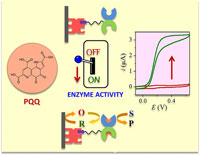Publication
743
Anal. Chem., 86 (4), 2257–2267, 2014
DOI:10.1021/ac500142e
|
|
|
|
|
|
 |
Heterogeneous reconstitution of the PQQ-dependent glucose dehydrogenase immobilized on an electrode: a sensitive strategy for PQQ detection down to picomolar levels. |
|
|
|
Ling Zhang, Rebeca Miranda-Castro, Claire Stines-Chaumeil, Nicolas Mano, Guobao Xu, Francois Mavré, and Benoit Limoges
Laboratoire d’Electrochimie Moléculaire, UMR 7591 CNRS, Université Paris Diderot, Sorbonne Paris Cité, 15 rue Jean-Antoine de Baïf, F-75205 Paris Cedex 13, France
State Key Laboratory of Electroanalytical Chemistry, Changchun Institute of Applied Chemistry, University of Chinese Academy of Sciences, Chinese Academy of Sciences, 5625 Renmin Street, Jilin 130022, China
Centre de Recherche Paul Pascal, Université de Bordeaux, UPR8641, Avenue Albert Schweitzer, 33600 Pessac, France
A highly sensitive electroanalytical method for determination of PQQ in solution down to subpicomolar concentrations is proposed. It is based on the heterogeneous reconstitution of the PQQ-dependent glucose dehydrogenase (PQQ-GDH) through the specific binding of its pyrroloquinoline quinone (PQQ) cofactor to the apoenzyme anchored on an electrode surface. It is shown from kinetics analysis of both the enzyme catalytic responses and enzyme surface-reconstitution process (achieved by cyclic voltammetry under redox-mediated catalysis) that the selected immobilization strategy (i.e., through an avidin/biotin linkage) is well-suited to immobilize a nearly saturated apoenzyme monolayer on the electrode surface with an almost fully preserved PQQ binding properties and catalytic activity. From measurement of the overall rate constants controlling the steady-state catalytic current responses of the surface-reconstituted PQQ-GDH and determination of the PQQ equilibrium binding (Kb = 2.4 × 1010 M–1) and association rate (kon = 2 × 106 M–1 s–1) constants with the immobilized apoenzyme, the analytical performances of the method could be rationally evaluated, and the signal amplification for PQQ detection down to the picomolar levels is well-predicted. These performances outperform by several orders of magnitude the direct electrochemical detection of PQQ in solution and by 1 to 2 orders the detection limits previously achieved by UV–vis spectroscopic detection of the homogeneous PQQ-GDH reconstitution. |

